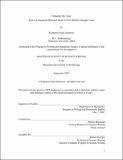Changing her tune : how a transsexual woman claims a new identity through voice
Author(s)
Gammon, Katharine Stoel
DownloadFull printable version (241.1Kb)
Alternative title
How a transsexual woman claims a new identity through voice
Other Contributors
Massachusetts Institute of Technology. Graduate Program in Science Writing.
Advisor
Marcia Bartusiak.
Terms of use
Metadata
Show full item recordAbstract
The human voice is an important indicator of a person's gender. For male-to-female transgender individuals (or transsexuals) the voice is one of the most difficult parts of the gender transition. Males have larger and heavier vocal apparatuses (larynx and vocal folds), which generally produce a lower sound. Transgender women can have voice surgery, but it can sometimes cause a Minnie Mouse-like falsetto or the complete loss of the voice. As a result, many transgendered women turn to specially trained voice therapists to learn how to speak more convincingly like women. The voice's pitch, although important, is not the only factor in creating a more female sound. Intonation, resonance, volume, speech patterns and formant frequencies also play significant roles in making a realistic feminine sound. There continue to be many unanswered questions about how listeners perceive the voices of transgender women and how best to blend the voices of transwomen into a comfortable range. Transgender women have many hurdles to face as they transition from male to female, and possessing an authentic voice is a way to smooth out the bumpy path they face.
Description
Thesis (S.M. in Science Writing)--Massachusetts Institute of Technology, Dept. of Humanities, Graduate Program in Science Writing, 2007. "September 2007." Includes bibliographical references (leaves 36-37).
Date issued
2007Department
Massachusetts Institute of Technology. Graduate Program in Science Writing; MIT Program in Writing & Humanistic StudiesPublisher
Massachusetts Institute of Technology
Keywords
Graduate Program in Science Writing.